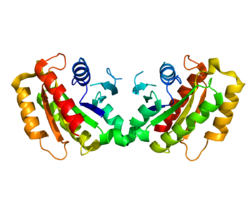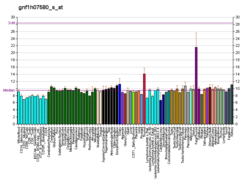LRRK2
LRRK2(leucine-rich repeat kinase 2)は、Dardarin(バスク語で「震え」を意味する"dardara"に由来する)やPARK8(初期にパーキンソン病との関係が明らかにされたことに由来する)の名称でも知られるプロテインキナーゼであり、ヒトではLRRK2遺伝子によってコードされる[5]。LRRK2はロイシンリッチリピートキナーゼファミリーのメンバーである。LRRK2遺伝子の変異はパーキンソン病やクローン病のリスクの増加と関係している[5][6]。
機能[編集]
LRRK2は、アルマジロリピート(ARM)領域、アンキリンリピート(ANK)領域、ロイシンリッチリピート(LRR)ドメイン、キナーゼドメイン、GTPアーゼ(ROC)ドメイン、COR(C-terminal of ROC)ドメイン、WD40ドメインを持つ[7]。このタンパク質は主に細胞質に存在するが、ミトコンドリア外膜とも結合している。
LRRK2はパーキンのC末端のR2 RINGフィンガードメインと相互作用し、パーキンはLRRK2のCORドメインと相互作用する。神経芽腫細胞やマウス皮質神経細胞において、LRRK2変異体の発現はアポトーシスによる細胞死を誘導する[8]。
常染色体優性型パーキンソン病への関与が示唆されている変異型LRRK2の発現は、in vivoと培養神経細胞の双方で神経突起の長さや分枝の減少を引き起こす[9]。この効果はマクロオートファジーの変化がその一因となっており[10][11][12][13][14]、プロテインキナーゼAによるオートファジータンパク質LC3の調節によって阻害される[15]。G2019SやR1441C変異はシナプス後のカルシウムバランスの異常を引き起こし、マイトファジーによって樹状突起からミトコンドリアの過剰な除去をもたらす[16]。LRRK2はシャペロン介在性オートファジー(chaperone-mediated autophagy)の基質でもある[17]。
臨床的意義[編集]
LRRK2遺伝子の変異はパーキンソン病8型(PARK8)と関係している[18]。
G2019S変異ではキナーゼ活性の亢進がみられ、この変異は白人の家族性パーキンソン病の原因として比較的広くみられる[19]。この変異は孤発性パーキンソン病を引き起こしている可能性もある。変異が生じるグリシン残基は全ての生物種のキナーゼドメインで保存されている。
G2019S変異は、LRRK2遺伝子の変異としてパーキンソン病の原因となることが実証されている少数の例の1つである。G2019S変異は西洋諸国で最も一般的な変異であり、北アメリカの白人のパーキンソン病の全ての症例の約2%を占める。またこの変異は特定の集団に高頻度でみられ、アシュケナジムのパーキンソン病患者の約20%、北アフリカのベルベル人に祖先を持つパーキンソン病患者の約40%に見つかる[20][21]。
ゲノムワイド関連解析によってLRRK2はパーキンソン病だけでなくクローン病とも関係していることが示されており、この2つの疾患が共通した経路を持つことが示唆されている[22][23]。
出典[編集]
- ^ a b c GRCh38: Ensembl release 89: ENSG00000188906 - Ensembl, May 2017
- ^ a b c GRCm38: Ensembl release 89: ENSMUSG00000036273 - Ensembl, May 2017
- ^ Human PubMed Reference:
- ^ Mouse PubMed Reference:
- ^ a b “Cloning of the gene containing mutations that cause PARK8-linked Parkinson's disease”. Neuron 44 (4): 595–600. (November 2004). doi:10.1016/j.neuron.2004.10.023. PMID 15541308.
- ^ “Mutations in LRRK2 cause autosomal-dominant parkinsonism with pleomorphic pathology”. Neuron 44 (4): 601–7. (November 2004). doi:10.1016/j.neuron.2004.11.005. PMID 15541309.
- ^ 川上文貴; 市川尊文『パーキンソン病原因分子LRRK2によるTauの異常リン酸化機構』公益社団法人日本生化学会、2016年4月25日。doi:10.14952/seikagaku.2016.880248。2022年5月8日閲覧。
- ^ “Leucine-rich repeat kinase 2 (LRRK2) interacts with parkin, and mutant LRRK2 induces neuronal degeneration”. Proceedings of the National Academy of Sciences of the United States of America 102 (51): 18676–81. (December 2005). Bibcode: 2005PNAS..10218676S. doi:10.1073/pnas.0508052102. PMC 1317945. PMID 16352719.
- ^ “The familial Parkinsonism gene LRRK2 regulates neurite process morphology”. Neuron 52 (4): 587–93. (November 2006). doi:10.1016/j.neuron.2006.10.008. PMID 17114044.
- ^ “Role of autophagy in G2019S-LRRK2-associated neurite shortening in differentiated SH-SY5Y cells”. Journal of Neurochemistry 105 (3): 1048–56. (May 2008). doi:10.1111/j.1471-4159.2008.05217.x. PMC 2361385. PMID 18182054.
- ^ “Disrupted autophagy leads to dopaminergic axon and dendrite degeneration and promotes presynaptic accumulation of α-synuclein and LRRK2 in the brain”. The Journal of Neuroscience 32 (22): 7585–93. (May 2012). doi:10.1523/JNEUROSCI.5809-11.2012. PMC 3382107. PMID 22649237.
- ^ “Leucine-rich repeat kinase 2 regulates autophagy through a calcium-dependent pathway involving NAADP”. Human Molecular Genetics 21 (3): 511–25. (February 2012). doi:10.1093/hmg/ddr481. PMC 3259011. PMID 22012985.
- ^ Cai, Huaibin, ed (April 2011). “Dopaminergic neuronal loss, reduced neurite complexity and autophagic abnormalities in transgenic mice expressing G2019S mutant LRRK2”. PLOS ONE 6 (4): e18568. Bibcode: 2011PLoSO...618568R. doi:10.1371/journal.pone.0018568. PMC 3071839. PMID 21494637.
- ^ “LRRK2 regulates autophagic activity and localizes to specific membrane microdomains in a novel human genomic reporter cellular model”. Human Molecular Genetics 18 (21): 4022–34. (November 2009). doi:10.1093/hmg/ddp346. PMC 2758136. PMID 19640926.
- ^ “Regulation of the autophagy protein LC3 by phosphorylation”. The Journal of Cell Biology 190 (4): 533–9. (August 2010). doi:10.1083/jcb.201002108. PMC 2928022. PMID 20713600.
- ^ “Mutant LRRK2 elicits calcium imbalance and depletion of dendritic mitochondria in neurons”. The American Journal of Pathology 182 (2): 474–84. (February 2013). doi:10.1016/j.ajpath.2012.10.027. PMC 3562730. PMID 23231918.
- ^ “Interplay of LRRK2 with chaperone-mediated autophagy”. Nature Neuroscience 16 (4): 394–406. (April 2013). doi:10.1038/nn.3350. PMC 3609872. PMID 23455607.
- ^ “Entrez Gene: LRRK2 leucine-rich repeat kinase 2”. 2022年5月11日閲覧。
- ^ “A common LRRK2 mutation in idiopathic Parkinson's disease”. Lancet 365 (9457): 415–6. (February 2005). doi:10.1016/S0140-6736(05)17830-1. PMID 15680457.
- ^ “Phenotype, genotype, and worldwide genetic penetrance of LRRK2-associated Parkinson's disease: a case-control study”. The Lancet. Neurology 7 (7): 583–90. (July 2008). doi:10.1016/S1474-4422(08)70117-0. PMC 2832754. PMID 18539534.
- ^ “LRRK2 G2019S as a cause of Parkinson's disease in North African Arabs”. The New England Journal of Medicine 354 (4): 422–3. (January 2006). doi:10.1056/NEJMc055540. PMID 16436781.
- ^ “Genomewide association studies and assessment of the risk of disease”. The New England Journal of Medicine 363 (2): 166–76. (July 2010). doi:10.1056/NEJMra0905980. PMID 20647212.
- ^ “Imputation of sequence variants for identification of genetic risks for Parkinson's disease: a meta-analysis of genome-wide association studies”. Lancet 377 (9766): 641–9. (February 2011). doi:10.1016/S0140-6736(10)62345-8. PMC 3696507. PMID 21292315.
関連文献[編集]
- “Altered alpha-synuclein homeostasis causing Parkinson's disease: the potential roles of dardarin”. Trends in Neurosciences 28 (8): 416–21. (August 2005). doi:10.1016/j.tins.2005.05.009. PMID 15955578.
- “LRRK2 in Parkinson's disease: protein domains and functional insights”. Trends in Neurosciences 29 (5): 286–93. (May 2006). doi:10.1016/j.tins.2006.03.006. PMID 16616379.
- “PARK8 LRRK2 parkinsonism”. Current Neurology and Neuroscience Reports 6 (4): 287–94. (July 2006). doi:10.1007/s11910-006-0020-0. PMID 16822348.
- “The pleomorphic pathology of inherited Parkinson's disease: lessons from LRRK2”. Current Neurology and Neuroscience Reports 6 (5): 355–7. (September 2006). doi:10.1007/s11910-996-0013-z. PMID 16928343.
- “The importance of LRRK2 mutations in Parkinson disease”. Archives of Neurology 63 (9): 1225–8. (September 2006). doi:10.1001/archneur.63.9.1225. PMID 16966498.
- “Clinical and pathologic features of families with LRRK2-associated Parkinson's disease”. Parkinson's Disease and Related Disorders. (2006). 221–229. doi:10.1007/978-3-211-45295-0_34. ISBN 978-3-211-28927-3. PMID 17017533
- Gasser, T. (2006). “Molecular genetic findings in LRRK2 American, Canadian and German families”. Parkinson's Disease and Related Disorders. 231–234. doi:10.1007/978-3-211-45295-0_35. ISBN 978-3-211-28927-3. PMID 17017534
- “Identification of a common genetic risk variant (LRRK2 Gly2385Arg) in Parkinson's disease”. Annals of the Academy of Medicine, Singapore 35 (11): 840–2. (November 2006). PMID 17160203.







